for something that deep you want something that really can pass air through. density and air flow resistivity are usually correlated, but perhaps you can research what products are out there where you live and if there are some flow resistivity values shared somewhere.Oh that’s interesting! So less dense can be better? It’s actually a mix at the front. I got denser roxul in front or looser roxul and some less dense pink fluffy stuff mixed in in parts
-
WANTED: Happy members who like to discuss audio and other topics related to our interest. Desire to learn and share knowledge of science required. There are many reviews of audio hardware and expert members to help answer your questions. Click here to have your audio equipment measured for free!
You are using an out of date browser. It may not display this or other websites correctly.
You should upgrade or use an alternative browser.
You should upgrade or use an alternative browser.
Got my REW reverberation (RT60) graphs. Please comment!
- Thread starter Snoochers
- Start date
- Thread Starter
- #22
Thanks for this. Unfortunately I think I’m done. All that insulation is leaning against the rear wall with wood and wires supporting it and everything so I don’t think I’m going back there ever again ha ha. I think the results are decently good?for something that deep you want something that really can pass air through. density and air flow resistivity are usually correlated, but perhaps you can research what products are out there where you live and if there are some flow resistivity values shared somewhere.
Yeah it looks good! But i'm guessing you're also here for some tips not just to brag aroundThanks for this. Unfortunately I think I’m done. All that insulation is leaning against the rear wall with wood and wires supporting it and everything so I don’t think I’m going back there ever again ha ha. I think the results are decently good?
- Thread Starter
- #24
Yes for sure, and I wouldn’t know if this data is brag worthy or embarrassing. If you told me was a huge issue and my data look like crap then I would certainly try to fix some things down the road. But if things look pretty good then I’m going to leave it as it is.Yeah it looks good! But i'm guessing you're also here for some tips not just to brag around
I do need to add diffusion. Will that affect reverb data like RT60?
Yes it will increase reverb, whether it will be obvious in the data is a good question though.Yes for sure, and I wouldn’t know if this data is brag worthy or embarrassing. If you told me was a huge issue and my data look like crap then I would certainly try to fix some things down the road. But if things look pretty good then I’m going to leave it as it is.
I do need to add diffusion. Will that affect reverb data like RT60?
Great job. Bass traps work.I have 30" deep base traps in the corners and the front wall is mostly 24" thick insulation
Oh I'm a bit confused sorry. Since these are reverb times, how does frequency response fit in? I did not include a standard SPL chart. Are you looking at the spectral decay or whatever it is called?
The top of your waterfall and decay plots show the frequency response.
You can see there is a ridge extending out from 70Hz, indicating some lingering energy. However, because this ridge corresponds with a peak in SPL, using EQ to remove the peak will also reduce the lingering energy.
There is a lot more lingering energy from 10-40Hz. This is basically impossible to treat without a much larger room. Fortunately, it is almost entirely inaudible, our brains sense of timing is poor in that region. Port output from your subwoofers could also be contributing, sealed subs are better for some applications, although home theatre should usually stick with ported.
- Thread Starter
- #29
Oh I see thank you! If this shows the frequency response then that could be slightly problematic to interpret. This sound I think is corrected with Anthem ARC and isn't virgin. I have not run a new correction with the treatments so could change a touch.The top of your waterfall and decay plots show the frequency response.
You can see there is a ridge extending out from 70Hz, indicating some lingering energy. However, because this ridge corresponds with a peak in SPL, using EQ to remove the peak will also reduce the lingering energy.
There is a lot more lingering energy from 10-40Hz. This is basically impossible to treat without a much larger room. Fortunately, it is almost entirely inaudible, our brains sense of timing is poor in that region. Port output from your subwoofers could also be contributing, sealed subs are better for some applications, although home theatre should usually stick with ported.
- Thread Starter
- #30
@alex-z @abdo123 @ernestcarl I ran REW today again after doing anthem ARC calibration and this is my SPL. I thought it would be flatter? These are KEF R7s so should be pretty good out of the box. The non EQed curves are slightly worse. I guess this is inside a room and I'm zoomed in fairly close... Any feedback would be helpful. This is with 1/3 smoothing.The top of your waterfall and decay plots show the frequency response.
You can see there is a ridge extending out from 70Hz, indicating some lingering energy. However, because this ridge corresponds with a peak in SPL, using EQ to remove the peak will also reduce the lingering energy.
There is a lot more lingering energy from 10-40Hz. This is basically impossible to treat without a much larger room. Fortunately, it is almost entirely inaudible, our brains sense of timing is poor in that region. Port output from your subwoofers could also be contributing, sealed subs are better for some applications, although home theatre should usually stick with ported.
@alex-z @abdo123 @ernestcarl I ran REW today again after doing anthem ARC calibration and this is my SPL. I thought it would be flatter? These are KEF R7s so should be pretty good out of the box. The non EQed curves are slightly worse. I guess this is inside a room and I'm zoomed in fairly close... Any feedback would be helpful. This is with 1/3 smoothing.
View attachment 220292
Speakers which measure flat anechoic are not flat in-room. The downward trending response is exactly what you would expect due the reflectivity of a typical room. It should sound good, downward trending in-room response lines up with human hearing preference.
I assume green and blue represent your left and right front channels? It is a bit unusual to have that much difference in response above 3000Hz, and it will likely throw off the imaging a bit. Are the speakers and room laid out symmetrically? I would bust out the tape measure and make sure everything is inch perfect.
That dip at 60-70Hz is going to be your most audible problem. Are you running a single, or multiple subwoofers? Given the level of acoustic treatment you have, 1-2 good subs and some mild EQ should easily fix that.
ernestcarl
Major Contributor
@alex-z @abdo123 @ernestcarl I ran REW today again after doing anthem ARC calibration and this is my SPL. I thought it would be flatter? These are KEF R7s so should be pretty good out of the box. The non EQed curves are slightly worse. I guess this is inside a room and I'm zoomed in fairly close... Any feedback would be helpful. This is with 1/3 smoothing.
View attachment 220292
It’s quite possible that one of the speakers is more distant or angled more off-axis causing the broad difference in the mid-HF.
If nothing can be done physically (e.g. changing positioning and placement), broad BW or wide Q PEQs and/or shelving filters should be easy enough to apply to compensate. One could also listen to pink noise 800Hz and up played solo in each speaker to confirm — basically just a quick A/B test using your ears instead of just measurements.
I agree with @alex-z that the dip in the bass is going to be the most audible issue. Assuming the speakers are playing full-range and not augmented with a sub(s), there’s room for improvement.
- Thread Starter
- #33
Speakers which measure flat anechoic are not flat in-room. The downward trending response is exactly what you would expect due the reflectivity of a typical room. It should sound good, downward trending in-room response lines up with human hearing preference.
I assume green and blue represent your left and right front channels? It is a bit unusual to have that much difference in response above 3000Hz, and it will likely throw off the imaging a bit. Are the speakers and room laid out symmetrically? I would bust out the tape measure and make sure everything is inch perfect.
That dip at 60-70Hz is going to be your most audible problem. Are you running a single, or multiple subwoofers? Given the level of acoustic treatment you have, 1-2 good subs and some mild EQ should easily fix that.
It’s quite possible that one of the speakers is more distant or angled more off-axis causing the broad difference in the mid-HF.
If nothing can be done physically (e.g. changing positioning and placement), broad BW or wide Q PEQs and/or shelving filters should be easy enough to apply to compensate. One could also listen to pink noise 800Hz and up played solo in each speaker to confirm — basically just a quick A/B test using your ears instead of just measurements.
I agree with @alex-z that the dip in the bass is going to be the most audible issue. Assuming the speakers are playing full-range and not augmented with a sub(s), there’s room for improvement.
Perhaps the speakers aren't perfectly aligned but they should be reasonably close. They're toed in horizontally and a touch vertically and maybe the mic wasn't dead center. I'm not too worried about the higher end discrepancies though I will have a look.
The dip in the lower end is a concern indeed. I am running two subs at the mid points of two opposing walls and this is with Anthem ARC EQ already on. I guess I will take another measurement with the mic in a slightly different location and see if the problem repeats itself?
ernestcarl
Major Contributor
I guess I will take another measurement with the mic in a slightly different location and see if the problem repeats itself?
You could do that... certainly more measurements would be useful if you want to find out the evenness of the bass distribution in your listening room beyond the center MLP. Perhaps a MMM would be interesting to see as well.
I am running two subs at the mid points of two opposing walls and this is with Anthem ARC EQ already on.
It would be helpful to show overlay views of the raw and/or initial/base filtered responses as an illustration tool for others -- that way we can see how changes from the original base/unfiltered settings progresses post "correction" or after any kind of adjustment is made.
Unfortunately, I have never used an AVR or multi-sub setup in practice... but from my own limited experience, one of the best ways of finding out what the best possible "sum" of multiple speakers and sub(s) without an AVR would be to model stuff in software based on good "raw" measurements first.
This is essentially how I do things now compared to some years before where I changed my setup and settings in almost seemingly random order until I get it right in the ballpark of where "I think" I want to be...
Pictures attached of some very useful "overlay" graphical views just as an example using REW and rePhase.
Attachments
-
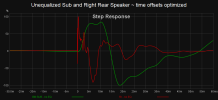 1a Step.png33.9 KB · Views: 64
1a Step.png33.9 KB · Views: 64 -
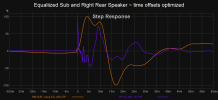 1b Step.png37.7 KB · Views: 67
1b Step.png37.7 KB · Views: 67 -
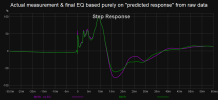 1c Step.png31.3 KB · Views: 65
1c Step.png31.3 KB · Views: 65 -
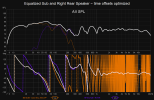 3b Alignment tool.png152.4 KB · Views: 76
3b Alignment tool.png152.4 KB · Views: 76 -
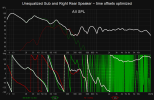 3a Alignment tool.png144.3 KB · Views: 67
3a Alignment tool.png144.3 KB · Views: 67 -
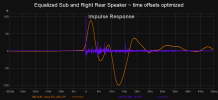 2b IR.png38.6 KB · Views: 66
2b IR.png38.6 KB · Views: 66 -
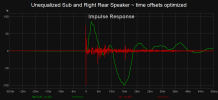 2a IR.png35.8 KB · Views: 71
2a IR.png35.8 KB · Views: 71 -
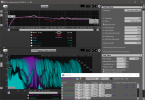 4 REW EQ Window.png586.7 KB · Views: 79
4 REW EQ Window.png586.7 KB · Views: 79 -
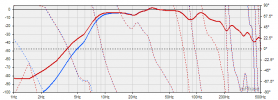 5 Sub partial linear phase HPF FIR .png13.7 KB · Views: 66
5 Sub partial linear phase HPF FIR .png13.7 KB · Views: 66 -
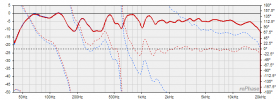 6 Rear Spkr Mid-HF phase linearization.png12.7 KB · Views: 71
6 Rear Spkr Mid-HF phase linearization.png12.7 KB · Views: 71
- Thread Starter
- #35
@alex-z @abdo123 @ernestcarl OK I played around some more and was able to get HDMI etc. Long story short here is my SPL from my LCR and my two subs. This is post EQ correction from Anthem ARC but the uncorrected isn't terribly different. As you can see a sizeable null in the 65hz region that I can't get rid of. My LFE low pass filter is at 120hz and my front crossover is at 80hz. What I don't understand is that my subs seem fine? And when I move the LFE or crossovers to insane values like 40hz or 200hz or even turn some things off the null is still there (or widens). How can I have this null if the subs seem fine and my front speakers shouldn't be playing much around 65hz? I'm obviously missing something here...

Is the light green and orange line each of your subwoofers individually?
Does the null show up in the combined subwoofer response?
What happens if you flip the subwoofer polarity/phase 180 degrees?
Asking these questions because usually that sort of null is caused by time alignment issues between the subs themselves, or the subs + speakers.
Does the null show up in the combined subwoofer response?
What happens if you flip the subwoofer polarity/phase 180 degrees?
Asking these questions because usually that sort of null is caused by time alignment issues between the subs themselves, or the subs + speakers.
ernestcarl
Major Contributor
@alex-z @abdo123 @ernestcarl OK I played around some more and was able to get HDMI etc. Long story short here is my SPL from my LCR and my two subs. This is post EQ correction from Anthem ARC but the uncorrected isn't terribly different. As you can see a sizeable null in the 65hz region that I can't get rid of. My LFE low pass filter is at 120hz and my front crossover is at 80hz. What I don't understand is that my subs seem fine? And when I move the LFE or crossovers to insane values like 40hz or 200hz or even turn some things off the null is still there (or widens). How can I have this null if the subs seem fine and my front speakers shouldn't be playing much around 65hz? I'm obviously missing something here... View attachment 221003
There may be some phase difference induced cancellation from a not so optimal bass-managed sub + mains xo EQ and time alignment. It would be informative to see the response of the main on their own overlayed with the sub (non-LFE) response. The "time-of-flight" or time alignment between sub and main channels is also not shown in your graphs -- for this you need an IR/step or ETC plots.
You could also use REW's alignment tool button found in the All SPL tab options menu (gear/sprocket icon) to check for the theoretical sum of your separate measurements...
----------
Alternatively, if you notice the LFE (+10 dB signal) is at odds with the bass-managed subwoofer signal itself -- which is to be subsequently summed with the mains (SPL leveled more in line with the mains so minus the +10 dB boost), it may be that the LFE signal's non-low-passed response electronically cancels out with the bass-managed sub signal's low-passed response. The latter can easily be fixed by the addition of an all-pass filter or pure time delay applied to the LFE channel prior summing with the low-passed, bass-managed signal.
In the examples I have shown here, for my DESK 7.1c setup, a 200 Hz all-pass filter is needed to be applied to the LFE signal before electronically summing with the low-passed (-10 dB level and 200 Hz Butterworth 24dB/oct) bass-managed subwoofer signal. Without an all-pass filter applied, the LFE will partially cancel out with the bass-managed sub signal when coherent channel source signals are passed through the processor.
In the case of my COUCH 5.1c (actually more like 4.1 -- without the center channel) setup, I do not apply any additional low-pass filtering to the bass managed sub response at all rendering the use of an all-pass filter moot -- thus it is entirely skipped.
In the three Smaart magnitude and phase response graphs below, you can clearly see that the separate LFE and bass-managed subwoofer responses (blue phase line) remains acoustically (and likely electronically as well I think) the same regardless of the difference in EQ applied. Depending on how the processor is designed, this kind of correction may or may not be performed.
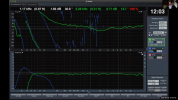

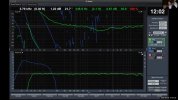
image examples taken from:
Probably the simplest BM implementation looks like this:
Something a bit more "tailored" may look like this:
Where each speaker set has a different HPF / mixed phase filter xo EQ design...
However, what may be missing is a simple all-pass filter applied to the LFE prior summing:
I do my own rudimentary MCH bass-management processing digitally via JRiver on my HPTC
(edited for clarity)
JRiver's convolution section applies a partially corrected linear phase HPF so that 15 Hz filter for the sub/LFE channels is left disabled above.
Below is yet another set of example steps I performed using REW's basic EQ and Alignment tools:
Frequency dependent window (FDW) 15 cycles applied

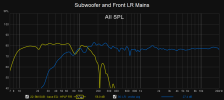

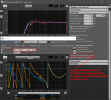
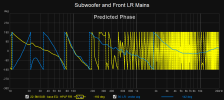
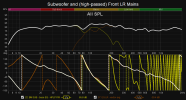

Here's a little summary of what was done:
- Make sure the time of flight (or rather arrival as measured at the microphone) for all speakers is as close to "zero" or t=0 in the IR/ETC graphs
- Make sure to adjust the SPL level of all speakers -- if the response you are dealing with is god-awfully non-linear, you might want to apply some preliminary EQ correction beforehand as in the two examples I've shown here.
- Apply HPF if desired in order to match the phase responses better across the relevant xo region. Occasionally an all-pass filter may be called for certain time sensitive applications to match speaker phases from vastly different speaker designs/models. If the processor has the capacity, sometimes a linear phase or mixed phase xo EQ can be applied instead to avoid an increase in group delay using ordinary min-phase HP filters.
- Check the predicted or generated phase response if they align close enough
- Create an "aligned sum" response measurement
- Make changes to your processor and verify the new settings and EQ corrections work as predicted
Hmmn... only thing I skipped was the convolution section part which some will not find relevant.
Last edited:
- Thread Starter
- #38
@alex-z @ernestcarl You guys are absolute champions. I've read your posts and tried a few things. I ended up landing on a page about my receiver that mentioned a new beta Anthem ARC version that had a comprehensive phase alignment analysis. It took a few minutes to run and that may have solved the issue?? What do you guys think? LCR are the long lines and the top purple one is LFE and the middle one is one of the subs on its own. There's room for improvement (especially for the purple LCR line?) but I think the huge 65hz null has been rectified? How's this looking otherwise?
I'm using 1/3 smoothing. Is that too generous?

EDIT: here is 1/6 smoothing

I'm using 1/3 smoothing. Is that too generous?
EDIT: here is 1/6 smoothing
Last edited:
That is looking much better. 1/3 octave smoothing is totally fine for general analysis and developing EQ filters.
The variance between the left and right channels from 150-600Hz is normally caused by room modes, or speaker boundary interference (energy from the baffle hitting the wall behind). Is the room itself symmetrical, and are the speakers placed at identical distance from the walls?
One thing you can do is place a 4-6" absorber between each speaker and the wall, that tends to help that region greatly.
I also see the response is dropping below 40Hz. Being a home theatre setup, I would recommend some more capable subwoofers. Ideally you want the response at 20Hz to actually be slightly higher than 40Hz.
The variance between the left and right channels from 150-600Hz is normally caused by room modes, or speaker boundary interference (energy from the baffle hitting the wall behind). Is the room itself symmetrical, and are the speakers placed at identical distance from the walls?
One thing you can do is place a 4-6" absorber between each speaker and the wall, that tends to help that region greatly.
I also see the response is dropping below 40Hz. Being a home theatre setup, I would recommend some more capable subwoofers. Ideally you want the response at 20Hz to actually be slightly higher than 40Hz.
- Thread Starter
- #40
Thanks for your reply. The room is mostly symmetrical and the speakers are similarly placed in terms of distance from the walls. I do have 4 inch absorbers at the first reflection. It might not be perfectly placed.That is looking much better. 1/3 octave smoothing is totally fine for general analysis and developing EQ filters.
The variance between the left and right channels from 150-600Hz is normally caused by room modes, or speaker boundary interference (energy from the baffle hitting the wall behind). Is the room itself symmetrical, and are the speakers placed at identical distance from the walls?
One thing you can do is place a 4-6" absorber between each speaker and the wall, that tends to help that region greatly.
I also see the response is dropping below 40Hz. Being a home theatre setup, I would recommend some more capable subwoofers. Ideally you want the response at 20Hz to actually be slightly higher than 40Hz.
My subwoofers are 21 inches each in huge 3 x 3 x 3 ported boxes. I forget the model numbers but they should be pretty potent. I will look at my equalization settings and see what’s going on there.
Similar threads
- Replies
- 2
- Views
- 420
- Replies
- 15
- Views
- 717
- Replies
- 10
- Views
- 1K
- Replies
- 1
- Views
- 492
